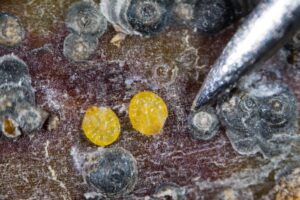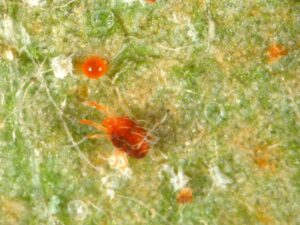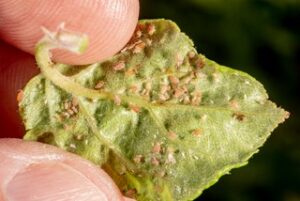Beginner and experienced tree fruit producers will want to be on the lookout now for a few mite and insect pests of tree fruit: the European Red Mite, Rosy Apple Aphid, and San Jose Scale. With the back-and-forth between warm and cool temperatures this spring, you may have fruit trees at different stages of development, so here’s just a few helpful tips of what to look for and when as it pertains to these three key early season mite and insect pests:
1) San Jose Scale: these are small, mostly sedentary insects that may be easy to miss to the untrained eye! These insects feed on twigs, limbs, and fruits of apple, peach, plum, and pear trees. While feeding, these scale insects inject toxins that damage wood, causing discoloration. You are most likely to see the female insects, which are wingless and sessile, living under a waxy, protective scale covering (Figure 2). San Jose scales overwinter on trees as immature scales and so are best managed with superior oil at Green Tip, which targets and suffocates the overwintered, immature scales. Be sure that you apply oil when temperatures are above 32 °F, for 24 hours before and after a planned application of oil. If your orchard has a history of San Jose Scale pressure and damage, you might consider using pheromone traps and tracking degree days to monitor the activity of adult males, which are very small and fly for only a short period of time. Insecticides can also be used later in the season to target the crawler stage and immature scale-stage of this pest.

Figure 1. Adult female San Jose scales under protective waxy covering (dark gray) and removed from waxy protective covering (yellow). Photo: John Obermeyer, Purdue Entomology
2) European Red Mite: these are small mites (Figure 2) that feed on the foliage of pome and stone fruit trees. The key management window for this pest is between Green Tip and Pink, and the specific life stage you are targeting during this window of time are the eggs. European red mites survive the winter as eggs, which are typically located at the base of buds and spurs. The eggs are best managed after Half-Inch Green and prior to Pink with superior oil, which does a great job suffocating and killing the eggs. However, good coverage with dormant oil is critical for controlling European red mite eggs. Again, be sure that you apply oil when temperatures are above 32 °F, for 24 hours before and after a planned application of oil. Last, but not least, the adult mites are susceptible to predatory (beneficial) mites that occur naturally in the orchard, and you can help conserve the “good mites” by using reduced risk rather than broad spectrum insecticides.

Figure 2. European red mite adult and egg on leaf surface (Photo: John Obermeyer, Purdue Entomology)
3) Rosy Apple Aphid: these are serious piercing-sucking pests of apple that while feeding, inject a toxin that causes leaves, shoots, and fruits to become distorted. The rosy apple aphid overwinters as an egg in tree bark crevices, bud axils, and twigs of apple trees, with eggs hatching after Silver Tip. This insect is best managed with superior oil alone or in combination with insecticides at Half-Inch Green to target newly hatched aphids, and through Pink to target established aphids (Figure 3), before serious leaf curl develops and limits good coverage necessary to manage this pest. A final reminder to be sure that you apply oil when temperatures are above 32 °F, for 24 hours before and after a planned application of oil.

Figure 3. Rosy apple aphids and their white cast-off skins on the underside of an apple leaf. Photo: John Obermeyer, Purdue Entomology
Here’s to a good bloom for all fruit producers and few issues with these mite and insect pests!